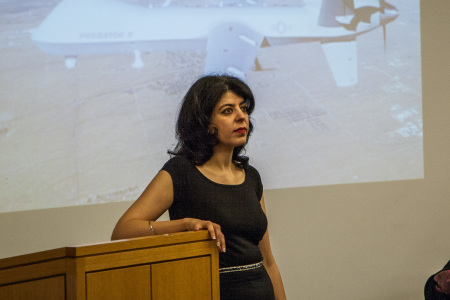Priya Satia, an associate professor of history at Stanford University, gave a talk titled “The Great War in the Middle East” in ARH 302 on Tuesday, Dec. 2, during which she explored and revealed the intricacies of British spy craft during World War I. Satia’s talk was part of the yearlong “A Century of War” series sponsored by the Center for the Humanities.
As a distinguished author, Satia has won numerous awards for her first book, “Spies in Arabia: The Great War and the Cultural Foundations of Britain’s Covert Empire in the Middle East.” In this series, she examines why the scenario of the Middle East challenged the way that espionage was conducted among British spies in the Iraqi and Syrian military zones.
During her talk, Satia covered the key elements that made the Middle East a critical area for British participation during WWI, speaking to a full room of students, faculty and staff. According to Satia, the unique landscape and ideology that surrounded Iran and Serbia forced the British to create innovative advances in military techniques, espionage and technology implemented on the war front.
Satia said that these advances occurred because the British romanticize their views of the Middle East. To them, the desert represented a biblical paradise of the past, one that they hoped to keep unchanged. This romantic notion of the landscape and completely opposite culture and war style encouraged British agents to engage in a different manner of espionage, Satia argued.

Photo by Sydney Steinly.
Satia explained that in the modern day, this oversimplification is often used to justify the complex relationship between technical advances in war paraphernalia and the Arab revolt.
“People like iPhones and people like drones,” she said.
Satia also argued that the mystical notions Europeans had of the Middle East resulted in the creation of bigger than life characters such as T. E. Lawrence, a British Army officer and spy, who believed that in order to win in the desert the British troops had to fight a war of detachment and “meet cunning with cunning.” Satia suggested that this led to the implementation of guerrilla style attacks on Arab camps and extensive use of airpower to destroy desired locations.
“There is a romance attached to a person who lives a double life; I do not know why this is romantically appealing but it is. Maybe, there is something innately fascinating about the act of concealment. I believe this fascination with spies comes out of a moment at the turn of the twentieth century where people’s class and national loyalties could be hidden,” Satia said about the phenomenon of spies during the war.
At the end of the talk, audience members asked about the origins of T. E. Lawrence’s fame and the effects that the newly developed espionage tactics had in regards to the validity of the information obtained by British intelligence.
“It was interesting to see how in this revolutionary time a fascination with the media and with literary figures changed the way the British saw war and fighting in the Middle East,” said Luke Jarzyna ’18, who attended the event.
Despite the fact that her talk focused mainly on WWI, Satia said that much of the current climate could be explained through looking back at the precedent set during this time.
“A lot of what is going on in the Middle East today is coming straight out of what happened in WWI. Also, the way the United States handles this problem mimics the British in WWI,” she said in an interview with The S&B.
Satia’s talk and approach seemed to appeal to many audience members, who cited her compelling argument and progression through multifaceted events that took place over the course of WWI.
“The talk was very interesting and she was very approachable. She really connected with her audience which made the talk even more enjoyable,” said attendee Rachel Fore ’18.
“She made this monolithic, unapproachable thing, more human, more relatable,” Jarzyna added.
Currently, with support from the National Endowment for Humanities and the American Council of Learned Societies, Satia is finishing her second book, “Empire of Guns: The British State, the Industrial Revolution, and the Conscience of a Quaker Arms-Maker.” Her author profile states that this book will examine the key role technology played in the development of the Middle Eastern conflict during WWI.



















































